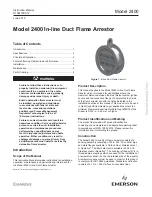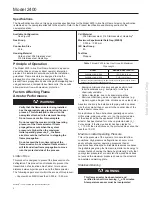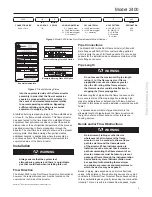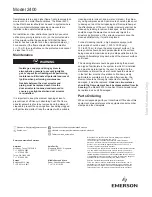
2
Model 2400
North America
Only
Specifications
The Specifications section on this page provides specifications for the Model 2400 In-line Duct Flame Arrestor. Specification
is stamped on the nameplate attached to the arrestor. Refer to the Product Identification and Marking section for the
nameplate details.
Available Configuration
See Figure 2
Gas Group
D
Connection Size
24 in.
Housing Material
Carbon steel, 304 Stainless steel,
316 Stainless steel, Hastelloy
®
Cell Material
304 Stainless steel, 316 Stainless steel, Hastelloy
®
Maximum Experimental Safe Gap (MESG)
0.035 in. / 0.90 mm
IEC Gas Group
IIA
Test Gas
Propane
Hastelloy
®
is a mark owned by Haynes International, Inc.
Principle of Operation
The Model 2400 In-line Duct Flame Arrestor is a passive
device that does not require direct operator interaction,
provided it is installed in accordance with the installation
guidelines. Flame arrestors are designed to stop the
propagation of confined low pressure deflagration. They
prevent flame propagation by absorbing and dissipating heat
using spiral wound crimped ribbon flame cells. These cells
allow maximum flow with maximum protection.
Factors Affecting Flame
Arrestor Performance
!
WARNING
Verify that the flame arrestor being installed
has the appropriate gas group rating for your
process. This information is shown on the
nameplate attached to the element housing.
Do not remove or alter this nameplate.
Do not exceed the maximum initial operating
pressure of the flame arrestor. If flame
propagation occurs when the system
pressure is higher than the maximum
initial operating pressure, P
0
, the flame
arrestor could be ineffective in stopping the
flame propagation.
Do not exceed the burn time rating of the
flame arrestor. An overheated flame arrestor
will fail and allow flame propagation to move
into the protected side of the process.
Limits of Use
This product is designed to prevent the transmission of a
deflagration. This product is not intended to prevent the
transmission of detonations. See Table 1 for maximum
distance between ignition source and the flame arrestor.
The following vapors are not within the scope of this product:
• Vapors with an MESG less than 0.035 in. / 0.90 mm.
• Explosive mixtures of vapors and gases which tend
to self-decompose (e.g. acetylene) or which are
chemically unstable.
• Carbon disulphide, due to its special properties.
• Mixtures other than gas-air or vapor-air mixtures (e.g.
higher oxygen-nitrogen ratio, chlorine as an oxidant, etc.).
Arrestors shall only be installed into piping with a nominal
size that is smaller than or equal to the nominal size of the
flame arrestor connection.
No restrictions or flow obstructions (partially open valve,
orifice plate, piping reduction, etc.) on the protected side
of the arrestor within the equivalent L/D that the flame
arrestor has been tested for on the unprotected side (L
u
).
For example, if the flame arrestor has been tested for
L
u
= 10 L/D, then restrictions on the protected side cannot be
less than 10 L/D.
Maximum Initial Operating Pressure
This is the pressure of the system at or near static flow
conditions. High pressure deflagrations can occur more
easily at higher system operating pressures than at
pressures near atmospheric. Elevated pressures condense
the ignitable gas giving the flame more matter and energy to
release thereby boosting the flame heat intensity. Verify that
your system pressure at or near static flow conditions does
not exceed the maximum pressure shown on the arrestor’s
nameplate and warning plate.
Stabilized Burning
!
WARNING
This flame arrestor has been tested and
certified for short time burning, t
bt
, of 8 minutes.
A temperature sensor must be incorporated
Table 1
. Model 2400 In-line Gas Group IIA Maximum
Pipe Length
MODEL
MAXIMUM PIPE LENGTH
(1)
2400/IIA-IL-XX-X-046
10 L/D (20 ft. / 6 m)
2400/IIA-IL-XX-X-059
7 L/D (14 ft. / 4 m)
1. Maximum length of pipe between the flame arrestor and the ignition source without
bends or other turbulence inducing devices (L
u
).






















